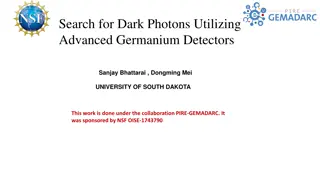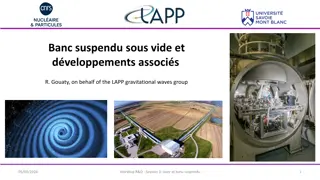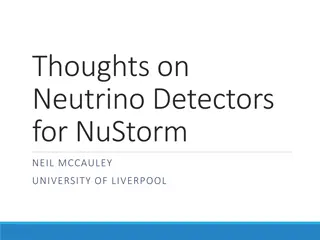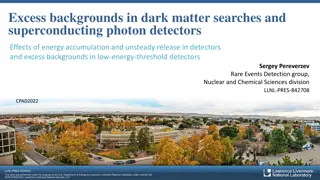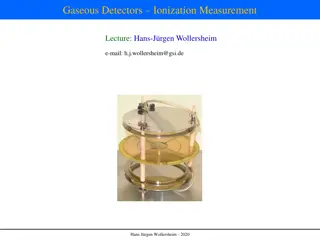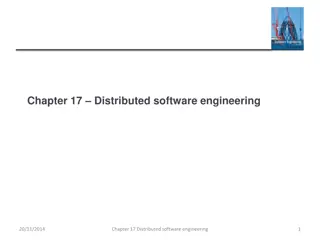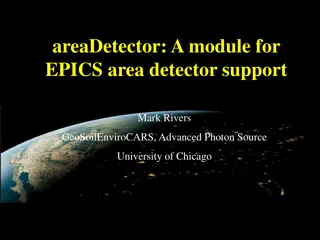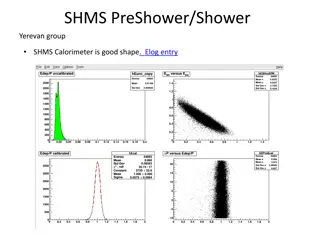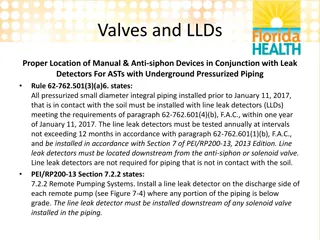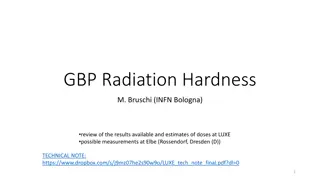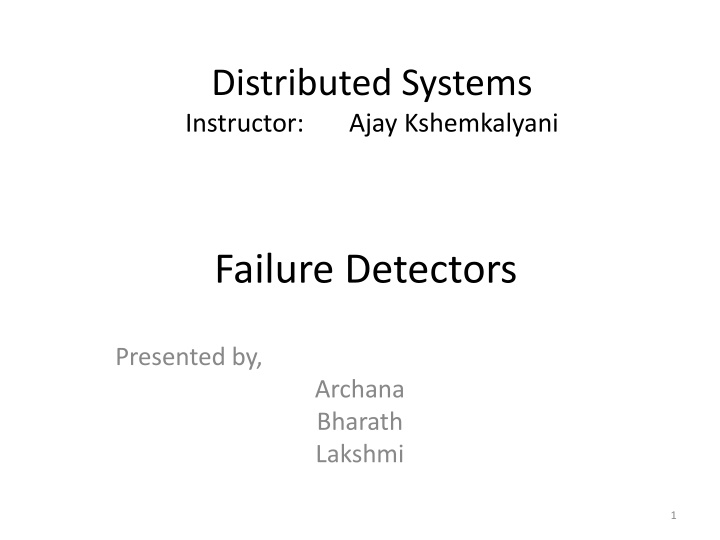
Failure Detectors in Distributed Systems
Failure detectors play a crucial role in detecting node failures in distributed systems, helping system designers build fault-tolerant platforms. Explore the significance of failure detectors, synchronous vs. asynchronous systems, safety, liveness properties, and more in this informative content.
Download Presentation

Please find below an Image/Link to download the presentation.
The content on the website is provided AS IS for your information and personal use only. It may not be sold, licensed, or shared on other websites without obtaining consent from the author. If you encounter any issues during the download, it is possible that the publisher has removed the file from their server.
You are allowed to download the files provided on this website for personal or commercial use, subject to the condition that they are used lawfully. All files are the property of their respective owners.
The content on the website is provided AS IS for your information and personal use only. It may not be sold, licensed, or shared on other websites without obtaining consent from the author.
E N D
Presentation Transcript
Distributed Systems Instructor: Ajay Kshemkalyani Failure Detectors Presented by, Archana Bharath Lakshmi 1
Failure Detector Failure detector is an application that is responsible for detection of node failures or crashes in a distributed system. A failure detector is a distributed oracle that provides hints about the operational status of other processes 2
Why Failure Detectors The design and verification of fault- tolerant distributed system is a difficult problem. The detection of process failures is a crucial problem, system designers have to cope with in order to build fault tolerant distributed platforms 3
Synchronous Vs Asynchronous A distributed system is synchronous if: there is a known upper bound on the transmission delay of messages there is a known upper bound on the processing time of a piece of code A distributed system is asynchronous if: there is no bound on the transmission delay of messages there is no bound on the processing time of a piece of code 4
Why Failure Detectors cont To stop waiting or not to stop waiting? Unfortunately, it is impossible to distinguish with certainty a crashed process from a very slow process in a purely asynchronous distributed system. Look at two major problems Consensus Atomic Broadcast 5
Liveness & Safety The problem can be defined with a safety and a liveness property. The safety property stipulates that nothing bad ever happens The liveness property stipulates that something good eventually happens 6
q not crashed The message from q to p is only very slow. Assuming that q has crashed will violate the safety property Slow q p 7
q has crashed To prevent the bad previous scenario from occurring, p must wait until it gets q s message. It is easy to see that p will wait forever, and the liveness property of the application will never be satisfied q p 8
Characterizing Failure Detectors Completeness Suspect every process that actually crashes Accuracy Limit the number of correct processes that are suspected 9
Completeness Strong Completeness Eventually, every crashed process is permanently suspected by every correct process Weak Completeness Eventually, every crashed process is permanently suspected by some correct process 10
Strong Completeness Suspectsp2{p1,p4} p2 p1 Suspectsp3{p1,p4} p3 p0 Suspectsp0{p1,p4} p5 p4 Suspectsp5{p1,p4} 11
Weak Completeness Suspectsp2{} p2 p1 Suspectsp3{p1,p4} p3 p0 Suspectsp0{p1} p5 p4 Suspectsp5{p4} 12
Accuracy Strong Accuracy A process is never suspected before it crashes by any correct process Weak Accuracy Some correct process never suspected by any correct process Perpetual Accuracy! As these properties hold all the times 13
Eventual Accuracy Eventual Strong Accuracy After a time, correct processes do not suspect correct processes Eventual Weak Accuracy After a time, some correct process is not suspected by any correct process 14
Failure Detector Classes Completeness Accuracy Strong Weak Eventual Strong Eventually Perfect P P v v Eventual Weak Eventually Strong S S Eventually Weak W W 0 Perfect P P Strong S S Strong Weak W W Weak v v 15
Reducibility A Failure detector D is reducible to another failure detector D if there exist a reduction algorithm TD -> D that transforms D to D . Then D is Weaker than D (i.e) D D If D D and D D then D and D are equivalent (i.e) D D Suppose a given algorithm A requires failure detector D , but only D is available. 16
Example 17
Reducibility of FD P P v ; v v P P ; ; W v ; S v ; S v ; v ; S S W ; P W ; P S W W S ; v v P P ; ; W S v ; S W S ; W S P v ; W ; P v ; P S W ; P S W W Hence if we solve a problem for four failure detectors with strong completeness, the problem is automatically solved for the remaining four failure detectors. 18
Comparing Failure detectors by Reducibility v v v v 19
Failure Detectors : Reducibility Two failure detectors are equivalent if they are reducible to each other. Failure detector with weak completeness is equivalent to corresponding failure detector with strong completeness. P v ; P v ; S W ; S W Solving a problem for the four failure detectors with strong completeness, automatically solves for the remaining four failure detectors. 20
Weak to Strong Completeness Every process p executes the following: Output p Null cobegin //Task 1: repeat forever suspects p D p {p queries its local failure detector module D p} send(p, suspects p) to all other processes. //Task 2: when receive (q, suspects q) for a process q output p output p suspects q {q} {output p emulates E p} coend 21
Weak to Strong Completeness F,C B A E F C E D E,C 22
Weak to Strong Completeness C,E C,E B A F C,E C E,C E D 23
The consensus problem Termination : Every correct process eventually decides some value. Uniform integrity : Every process decides at most once. Agreement : No two correct processes decide differently. Uniform validity : If a process decides a value v, then some process proposed v. It is widely known that the consensus cannot be solved in asynchronous systems in the presence of even a single crash failure 24
Solutions to the consensus problem P v ; P v ; S W ; S W Solving a problem for the four failure detectors with strong completeness, automatically solves for the remaining four failure detectors Since P is reducible to S and P is reducible to S. The algorithm for solving consensus using S also solve consensus using P. The algorithm for solving consensus using S also solve consensus using P. 25
Solving Consensus using s : Rotating Coordinator Algorithms 1 2 3 Work for up to f < n/2 crashes Processes are numbered 1, 2, , n They execute asynchronous rounds 4 In round r , the coordinator is process (r mod n) + 1 In round r , the coordinator: - tries to impose its estimate as the consensus value - succeeds if does not crash and it is not suspected by S 28
Consensus using S S The algorithm goes through three Asynchronous stages Each stage has several asynchronous rounds Each round has 2 tasks Task 1 Four asynchronous phases Task 2 In the first stage, several decision values are proposed In second stage, a value gets locked: no other decision value is possible In the third and final stage, the processes decide on the locked value and consensus is reached. 29
Consensus using S S Task 1 Phase1 Every process p sends Current estimate to coordinator Cp Round number tsp Phase 2 Cp gathers (n+1)/2 estimates Selects one with largest time stamp estimatep Send the new estimate to all processes Phase 3 Each process p May receive estimatep Send an ack to Cp May not receive estimatep Send an nack to Cp (suspecting Cp has crashed) Phase 4 Waits for (n+1)/2 (acks or nacks) If all are acks then estimatep is locked Cp broadcasts the decided value estimatep Task 2 If a process p receives a broadcast on decided value and has not already decided Accepts the value 30
Consensus using S S 2,ts2 1 2 3,ts3 3 Let ts2 < ts1 < ts3 31
Consensus using S S Estp =3 1 2 Estp =3 3 32
Consensus using S S ack 1 2 ack 3 33
Consensus using S S 3 3 2 3 3 Locks 3 and broad casts 34
Consensus using S S 3 3 3 Locks 3 and broad casts 35
Consensus using S cont S cont 37
Consensus using S cont S cont 38
Atomic Broadcast Informally, atomic broadcast requires that all correct processes deliver the same set of messages in the same order (i.e., deliver the same sequence of messages). Formally atomic broadcast can be defined as a reliable broadcast with the total order property Chandra and Toueg showed that the result of consensus can be used to solve the problem of atomic broad cast. 39
Reliable Broadcast Validity : If the sender of a broadcast message m is non-faulty, then all correct processes eventually deliver m. Agreement : If a correct process delivers a message m, then all correct processes deliver m. Integrity : Each correct process delivers a message at most once. Total Order If two correct processes p and q deliver two messages m and m , then p delivers m before m if and only if q delivers m before m . 40
Atomic Broadcast The algorithm consists of three tasks : Task 1 : when a process p wants to A-broadcast a message m, it R_broadcasts m. Task 2 : a message m is added to set R_deliveredp when process p R_delivers it. Task 3 : when a process p A_delivers a message m, it adds m to set A_deliveredp. Process p periodically checks whether A_undeliveredp contains messages. If it contains messages, p enters its next execution of consensus, say the kth one, and proposes A_undeliveredp as the next batch of messages to be A_delivered. 42
Implementation of failure detector Task 1 : Each process p periodically sends a p-is-alive message to all other processes. This is like a heart-beat message that informs other processes that process p is alive. Task 2 : If a process p does not receive a q-is-alive message from a process q within p(q) time units on its clock, then p adds q to its set of suspects if q is not already in the suspect list of p. Task 3 : When a process delivers a message from a suspected process, it corrects its error about the suspected process and increases its timeout for that process. If process p receives q-is-alive message from a process q that it currently suspects, p knows that its previous timeout on q was premature p removes q from its set of suspects and increases its timeout period for process q, p(q). 44
Lazy failure detection protocol A relatively simple protocol that allows a process to monitor another process, and consequently to detect its crash. This protocol enjoys the nice property to rely as much as possible on application messages to do this monitoring. The cost associated with the implementation of a failure detector incurs only when the failure detector is used (hence, it is called a lazy failure detector). Each process pi has a local hardware clock hci that strictly monotonically increases. The local clocks are not required to be synchronized Every pair of processes is connected by a channel and they communicate by sending and receiving messages through channels. Channels are not required to be FIFO 46
A short introduction to failure detectors for asynchronous Distributed Systems 48
Failure Detectors-Definition Why use FD? Based on well defined set of Abstract concepts Not dependant on any particular implementation Layered approach favors design, proof and portability of protocol Helps to solve impossible time-free asynchronous distributed system problems like the Consensus problem. Eventually accurate failure detectors helps in designing indulgent algorithms. 49
Asynchronous System Models Process model A process can fail by premature halting(crashing). A process is correct if it does not crash else it is faulty Computation models FLP Crash-prone processes and reliable links FLL Crash-prone processes and fair lossy links 50




